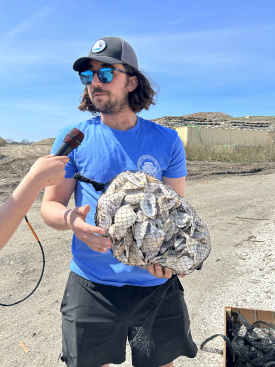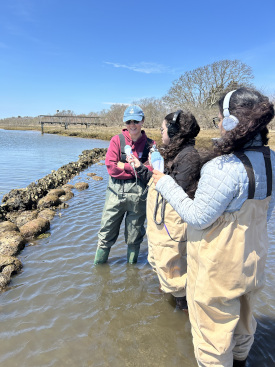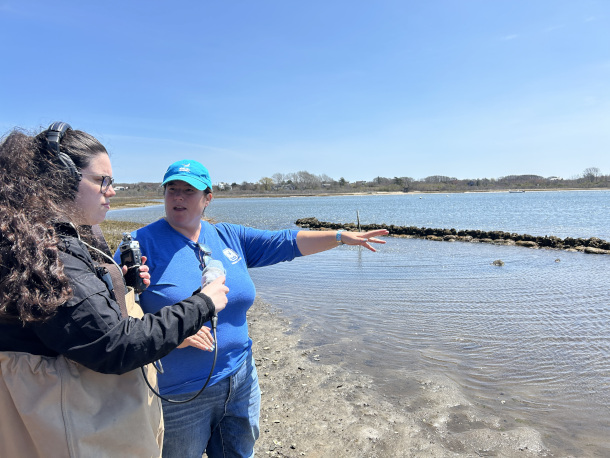Oyster Trash to Treasure
Air Date: Week of September 20, 2024

Living on Earth’s Sophia Pandelidis standing on the “shell mountain” at Nantucket’s Recycling Facility. (Photo: Living on Earth)
Oysters on the half shell are big business on Nantucket Island, and a local program that recycles oyster shells from restaurant waste into habitat for young oysters turns ten this year. Living on Earth’s Aynsley O’Neill reports on how these recycled oyster shell reefs are helping to protect the coastline from worsening storms and rising seas.
Transcript
CURWOOD: The reefs that provide habitat for oysters have declined worldwide by about 85% from before the 1800's, due to overharvesting, dredging, trawling, disease and pollution. That’s not just a problem for those of us who like them as a gourmet dish. Oyster reefs provide natural barriers to combat flooding from worsening storms and rising seas. So, on Nantucket Island, locals have found an approach to rebuilding reefs that helps their oysters thrive, protects their shores, and fills their bellies. With the help of producers Sophia Pandelidis and Paloma Beltran, Living on Earth’s Aynsley O’Neill took a trip to find out more.
[RESTAURANT SFX]
O’NEILL: The tiny island of Nantucket thirty miles off the coast of Massachusetts is both sustained and threatened by the steadily rising Atlantic Ocean. Once the whaling capital of the world, Nantucket now teems with up to 50,000 tourists a day who come for its beaches, and its top-of-the-line seafood.
[RESTAURANT SFX]

Living on Earth’s Paloma Beltran, Aynsley O’Neill, and Sophia Pandelidis (left to right) co-produced this story. (Photo: Living on Earth)
O’NEILL: Quahogs, scallops, clams…you name it, Nantucket’s got it. But there’s one shellfish that always gets people talking.
O’NEILL: “Honestly not sure I like it…”
O’NEILL: Oysters.
O’NEILL: You taste the ocean in this. That’s is a more pleasant version of opening your mouth while you’re swimming in the ocean.
O’NEILL: So yeah, they’re not my favorite. But a lot of folks who visit Nantucket’s restaurants and raw bars can’t get enough of them. So with that kind of demand, how do you keep the oysters coming? It all starts with the shuck.
[OYSTERS FALLING IN BUCKET]
O’NEILL: In the kitchen of The Sea Grille, Chef Tucker Harvey has mastered the art of oyster shucking.
[SFX OYSTER OPENS]
O’NEILL: A man of few words already, he didn’t have much to say when I asked if he had a special technique. After all, for him, it’s effortless.
HARVEY: The more you do it, the quicker you get, so, yeah. [LAUGH]
O’NEILL: He says his kitchen goes through 1-200 a night.
[SFX OYSTER DROPS]

Griffin Harkins, an Assistant Biologist at the Nantucket Natural Resources Department, holds a bag of “cured” oyster shells ready to head to the hatchery. (Photo: Living on Earth)
O’NEILL: Altogether, Nantucket’s raw bars and restaurants easily dish out hundreds of thousands over the course of a summer season.…which leaves the island with a mountain of leftover shells. But they’re not just shucked and chucked. Nantucket’s shell recycling program turns ten this year. And Tucker says pitching in is a no brainer.
HARVEY: It’s pretty easy. They provide the all the buckets and everything. We basically just leave them outside and then they pick them up.
O’NEILL: At 4:30 every morning, those blue buckets filled to the brim are “schlepped” across the island to begin a process that will bring the oysters full circle.
[AMBI SHELL FACILITY SOUNDS]
[SHELL DUMPING SFX]
O’NEILL: Here at Nantucket’s recycling facility, there’s a stretch of land that’s exclusively for this shell dumping. And those daily deliveries from dozens of restaurants add up fast, so the pile is absolutely towering over me.

Living on Earth’s Aynsley O’Neill tries dumping some of the smelly oysters herself. (Photo: Living on Earth)
HARKINS: I think we have close to a half a million pounds of shells, so it is quite literally a shell mountain.
O’NEILL: Griffin Harkins is an Assistant Biologist at the Nantucket Natural Resources Department and he’s part of the team that hauls those buckets here. Clad in his department baseball cap and t-shirt, Griffin is laid-back, friendly and very helpful as he walks me through the full process. He warns me that even if you’ve got a gourmet taste for these oysters, the process of dumping their shells is definitely not glamorous.
HARKINS: Without further ado, we should drop the tailgate, open up some buckets, and plug our noses.
[SFX BUCKET OPENING]
O’NEILL: Shells will spend up to a year on these “shell mountains”, undergoing a process called “curing.”
[SFX SHELL DUMPING]
O’NEILL: Out here in the sun, any potentially harmful bacteria and pathogens have time to die off. And the birds and the bugs will take care of any remaining organic matter.
HARKINS: You know, it’s a little dusty, but there are no more meats, there’s no smell to it, and yeah, it’s good to go.
O’NEILL: So after a year, the shells are bleached and pristine - ready to be reintroduced to the environment with only minimal contamination. From the recycling facility, the shells head to the island hatchery, where they’ll house new life.
[HATCHERY SOUNDS]
O’NEILL: Oysters are threatened worldwide, and local efforts like those at Nantucket’s hatchery can keep numbers up. Here, biologists nurture all kinds of baby shellfish, called larvae.

The hatchery raises many shellfish youngsters, or larvae. (Photo: Living on Earth)
HARKINS: When you’re looking at larvae you can tell a lot of things right away, here you can tell their guts are nice and dark. They're pretty mobile and those are looking like healthy larvae to me.
O’NEILL: Once they’ve grown up a bit, the youngsters will be moved to a giant tub along with a slew of those recycled shells.
[SFX HATCHERY]
HARKINS: We’re going to bring our shellfish in day one, we bring all adult shellfish and this is something that we do between January and February.
O’NEILL: The baby oysters latch on and use the calcium carbonate from the old shells, to create their own new shells. After they’ve grown, many of these oysters are placed in ocean restoration projects.

Griffin Harkins stands at the dock of the Nantucket Hatchery. (Photo: Living on Earth)
[MARSH SOUNDS]
O’NEILL: Some end up here on one of Nantucket’s salt marshes - which are slowly washing away thanks to coastal erosion. But with a project like this, recovery of the marsh is not just possible; it’s happening.
[SFX SQUISHING & WATER]
JISUN: There’s SO much!
KARBERG: Mmhmm.
HARKINS: This is incredible.
KARBERG: This wasn’t here last year.
HARKINS: No.
O’NEILL: Jen Karberg, Senior Wetland Ecologist at the Nantucket Conservation Foundation, is the mastermind behind this restoration project, and she brings me out to Polpis Harbor to see what’s going on. She helps me climb into a pair of big, baggy waders before we head out on the reef. Knee-deep in the murky water, I cling to my recording kit and hope nothing gets splashed. We’re making our way to three rows of concrete blocks, or as Jen calls them “oyster castles”.

The oyster reef is bolstered by mesh bags filled with recycled oysters. (Photo: Living on Earth)
KARBERG: I actually like to think of them as like ecologist legos because they build together and they interlock and they connect together. And then when they're connected, they're pretty stable.
O’NEILL: Before being placed out on the water, these oyster castles took a trip to the hatchery so that oyster larvae could attach to them. And the blocks are also bolstered by mesh bags full of recycled shells with even more growing oyster larvae in tow. Put together, they create the perfect habitat to attract wild oysters and set the reef up to be self-sustaining. With the island expected to get over two feet of sea level rise by 2060, this project could protect the coastline and keep the water clean. That’s because a single adult oyster can filter up to 50 gallons of water a day. And the reef also provides a physical buffer between eroding shorelines and powerful storms that are getting more intense with climate change. The Nantucket Conservation Foundation plus a team of volunteers installed the reef back in 2021.

Climbing into waders was a necessity to visit the reef. (Photo: Living on Earth)
KARBERG: This is the very first intertidal Oyster Reef in Massachusetts. No one had built one of these here before. So we thought, ok, we'll do a research project. We'll prove that it's possible to build one of these reefs. We'll show how beneficial it is to the harbor and how it will protect the salt marsh at the same time.
O’NEILL: And although the reef is small – just about 40 meters– Jen says it has big potential.
KARBERG: It is really holding up really well. And we’ve had some decent storms in the past two years.
HARKINS: Yeah, especially this past season.
KARBERG: Yeah, and it’s, its here. It’s thriving and the oysters are alive, and… I love it, this reef is so exciting for me.
O’NEILL: She says the Foundation will continue studying the ecological impacts and benefits of the reef, and then maybe build more. But these barriers have a barrier of their own: money. While the costs of this first reef were offset by volunteer help, Jen says installing another reef would take at least $20,000. But Jen thinks the project could really set sail if Nantucket’s wealthy homeowners get on board. And there’s an upside for them, too.

Dr. Jennifer Karberg (center), Senior Wetland Ecologist at the Nantucket Conservation Foundation, shows Aynsley O'Neill (left) the reef. (Photo: Living on Earth)
KARBERG: I mean, when you live on the shoreline here, that’s a huge value to your home. You would keep your beach, you could keep your shoreline, and hopefully improve water quality at the same time.
O’NEILL: The Polpis Harbor reef—built from recycled oysters— could be a model for protecting other shorelines threatened around the world – in a sustainable, circular way. From the ocean, to your table, and back again. For Living on Earth, I’m Aynsley O’Neill.
Links
Learn more about shell recycling on Nantucket
Learn more about the Nantucket Conservation Foundation’s Oyster Restoration Project
MassGov | Nantucket Reef Restoration Project
Town of Nantucket | “Natural Resources Department: First Oyster Reef Restoration Project”
Living on Earth wants to hear from you!
Living on Earth
62 Calef Highway, Suite 212
Lee, NH 03861
Telephone: 617-287-4121
E-mail: comments@loe.org
Newsletter [Click here]
Donate to Living on Earth!
Living on Earth is an independent media program and relies entirely on contributions from listeners and institutions supporting public service. Please donate now to preserve an independent environmental voice.
NewsletterLiving on Earth offers a weekly delivery of the show's rundown to your mailbox. Sign up for our newsletter today!
 Sailors For The Sea: Be the change you want to sea.
Sailors For The Sea: Be the change you want to sea.
 The Grantham Foundation for the Protection of the Environment: Committed to protecting and improving the health of the global environment.
The Grantham Foundation for the Protection of the Environment: Committed to protecting and improving the health of the global environment.
 Contribute to Living on Earth and receive, as our gift to you, an archival print of one of Mark Seth Lender's extraordinary wildlife photographs. Follow the link to see Mark's current collection of photographs.
Contribute to Living on Earth and receive, as our gift to you, an archival print of one of Mark Seth Lender's extraordinary wildlife photographs. Follow the link to see Mark's current collection of photographs.
 Buy a signed copy of Mark Seth Lender's book Smeagull the Seagull & support Living on Earth
Buy a signed copy of Mark Seth Lender's book Smeagull the Seagull & support Living on Earth

